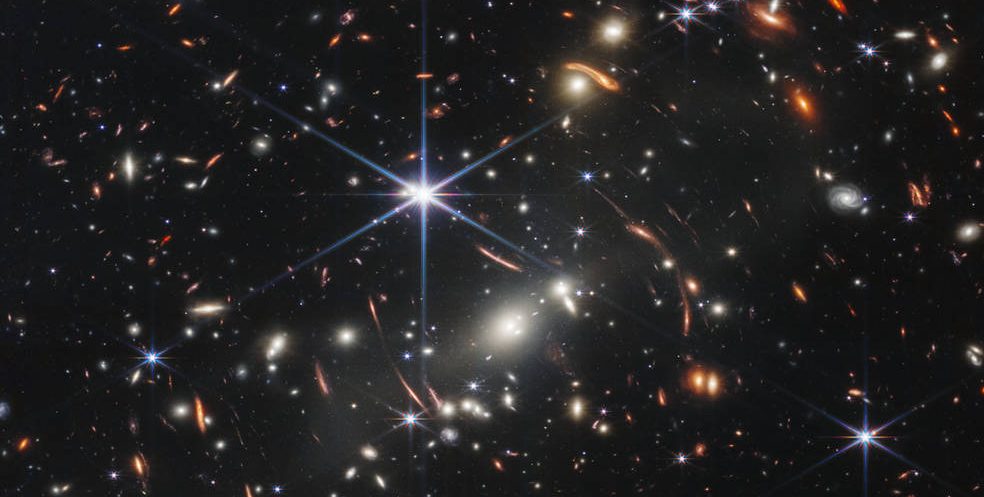How Utahns helped launch the James Webb Space Telescope

The world recently saw a glimpse of something we’ve never seen before: the deepest and sharpest infrared image of the early universe ever taken. And it was all thanks to the James Webb Space Telescope.
This is a magnificent achievement, and it wouldn’t have been possible without the help of several Utahns — all of whom deserve some recognition:
Materion
Working with NASA nearly 20 years ago, Materion engineered a special grade of gas-atomized beryllium from a mineral mine at Spor Mountain in Juab County — to construct the telescope. Beryllium is one-third lighter than aluminum, extremely stiff, and stable at very low temperatures. This metal helped scientists engineer the telescope’s primary, secondary, and tertiary mirror segments that allow us to see deeper into the universe.
“If it wasn’t for the beryllium mined in Utah, you wouldn’t see the images you’re seeing today,” says Keith Smith, Materion’s vice president of nuclear and science. “I’ve worked on this for 25 years … everything good is worth waiting for. And, throughout the company, we’re all just so excited.”
Materion also supplied highly-engineered metals that make up the telescope’s energy-producing solar panels, new bands for the NIRCam instrument, filters for the Near Infrared Imager and Slitless Spectrograph, and NIRCam coronographic occulting masks that help block out things that scientists don’t need to see.
Through partnerships with federal, state, and local partners, Materion has been able to mine and process beryllium while also reclaiming its land and creating a robust local workforce.
“Materion has been excellent for the Delta community and for Utah in general,” says Tom Henrie, global operations sustainability manager for Materion. “We’re really proud of the work being done here.”
We’re continually impressed by the forward-facing technology Materion engineers and are thankful for the hard-working crews who help provide these materials!
Moxtek
Moxtek also contributed to the James Webb Space Telescope’s groundbreaking mirror.
The Orem-based company collaborated with 4D Technology in Arizona to develop a wire-grid pixelated polarizer used to measure the flatness and quality of the telescope’s mirrors.
Moxtek became involved with this project over a decade ago when NASA approached 4D Technology to develop an optical tool to measure the flatness of the JWST’s telescope mirrors. 4D Technology successfully developed their approach using Moxtek’s advanced pixelated polarizer.
“There’s so much we don’t know about the universe that we’re going to be learning from this telescope, and we at Moxtek take a lot of pride in our contribution to this project,” says Shaun Ogden, senior product manager at Moxtek. “Without Moxtek’s polarizers, measuring the telescope mirrors with the required accuracy wouldn’t have been possible.”
Moxtek’s products have been used more than 10 times by NASA and the European Space Agency for space flight. We’re thankful for this collaborative effort and look forward to seeing what else Moxtek accomplishes in the future.
Northrop Grumman
Northrop Grumman, the largest aerospace and defense company in Utah, also played a big role in the production of the James Webb Space Telescope.
Northrop Grumman worked with then Magna-based aerospace manufacturer Orbital ATK to build the backplane structure that holds the telescope’s mirrors and optical instruments in place.
“Northrop Grumman is proud to lead our industry partners in the design, build, and total system integration of the observatory,” said Tom Wilson, corporate vice president and president, Space Systems Sector, Northrop Grumman. “We’re opening a new era of space exploration with [the telescope images], thanks to the groundbreaking engineering and partnership with NASA and the science community.”
Northrop Grumman has since acquired Orbital ATK and continues to work with NASA on projects that Utahns — and people around the world — can be proud of.
NASA’s James Webb Space Telescope, created out of a partnership with the European Space Agency and the Canadian Space Agency, launched Dec. 25, 2021, from Europe’s Spaceport in French Guiana, South America.
After completing a complex deployment sequence in space, the telescope underwent months of commissioning where its mirrors were aligned, and its instruments were calibrated to its space environment and prepared for science. All this led to the jaw-dropping images released on July 12, 2022.
Congratulations to everyone who has put so much effort into this. This administration joins the world in celebrating the science that brought us this incredible imagery.
Thank you all, and keep up the good work!
###